Project Description
Remember your first ever training session?
Do you remember thinking to yourself “Crap! What do I do?”
As you fumbled around, you heard the instructor, or your training partner, or some crazy over the top white belt from the side of the mat yell out, “GET GRIPS!”
Grips, of course…
…what a great idea!
Grips are obviously an integral part of Jiu Jitsu; however, chasing the wrong grip for your goals can prove costly…
Because the wrong grip…
… could get you swept…
… could get your guard passed…
… could get you tapped, or worse…
… could see you on the wrong end of some douche bags highlight video…
… I mean, hypothetically (wipes tears)
When we look for appropriate grips, we must first understand not only the purpose of the grip, but also its characteristics of control.
When you boil Jiu Jitsu down to its bare bits, you’ll see that the fundamental goal is to establish control over your opponent.
The greater the level of control you gain, the better your Jiu Jitsu.
Makes sense?
Great.
So, all you have to do is get your grips and you’re on your way to greatness, right?
Not quite…
You see, the 3 most utilized grips in BJJ, while greatly effective at all levels, are characterised by 2 overarching problems.
The 3 grips being:
- The Same Side Collar Grip
- The Cross Grip on the Collar
- The Sleeve Grip
And the 2 problems being:
- The relative ease of breaking
- The concentration of end line control
The degree to which you’ll face these problems will be lessened or intensified by the various positions you take…
However, for guard players, today we plan to offer you a solution to these problems…
But first, let’s take a look at the 3 grips in a little more detail…
The 3 Most Utilized Traditional Grips in BJJ
Before we talk about the 2 overarching problems faced by traditional BJJ grips, let’s first take a look at the 3 traditional gripping archetypes.
The Same Side Collar Grip
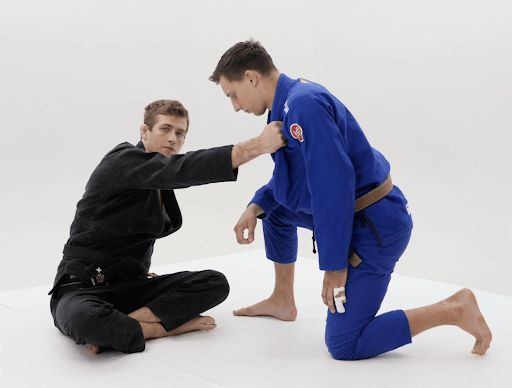
Here we see the fundamental same side collar grip.
A key characteristic of this grip is that it can be utilized in both attacking and defending situations…
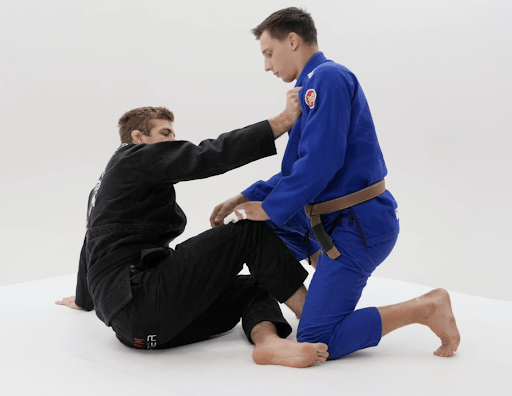
Against an aggressive opponent, one who is bearing down on you trying to close the distance, the same side collar grip, when used as a push, is very effective at maintaining chest to chest distance.
Much like a boxer’s jab, the push from a same side collar grip allows you to regulate distance to the extent of the length of your arm.

In attacking situations, the same side grip is used to provide a pulling force against your opponent, breaking their posture and taking them into the deep waters of your guard, where they’ll be open to sweeps and submissions.
However, while the same side collar grip provides sufficient push/pull control over your opponent, that push/pull can essentially only be performed in a LINEAR path of movement.
That is, your manipulation of their body is essentially restricted to a forward and backward motion.
Cross Grip on the Collar
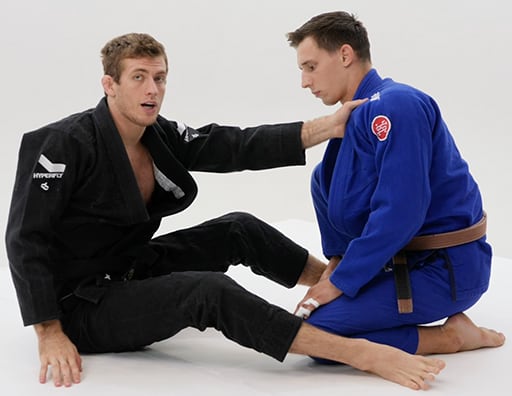
The characteristic benefit of our second most common grip, the cross collar grip, provides a rotational pulling motion over our opponent, allowing us to pull them across the side of our body…
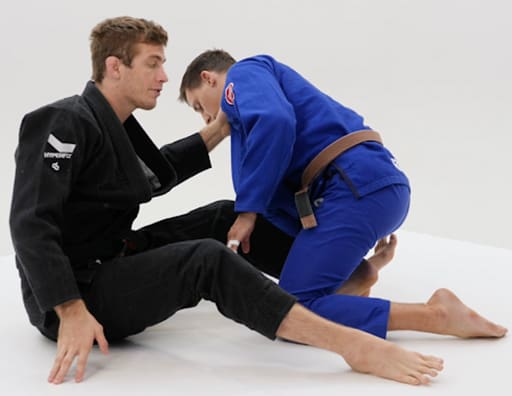
…opening up a number of opportunities to either stand, take the back, sweep, expose the arm or encourage the opponent to lift their leg.
While you can still push your opponent, to a certain extent, the cross collar is more of a pull dominant grip as opposed to the equal capacity for push and pull seen in the same side collar variation.
The Sleeve Grip
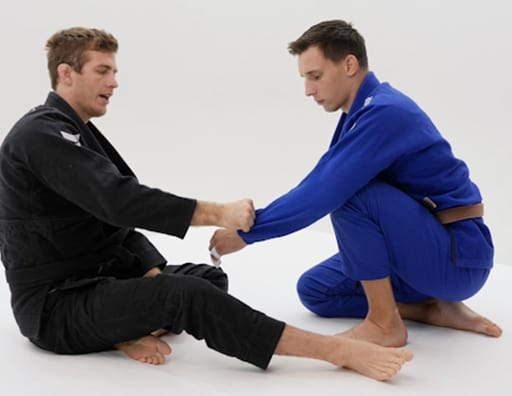
Sleeve grips have two variants.
One, being the spider guard/cat’s paw variation seen here.
While the other…
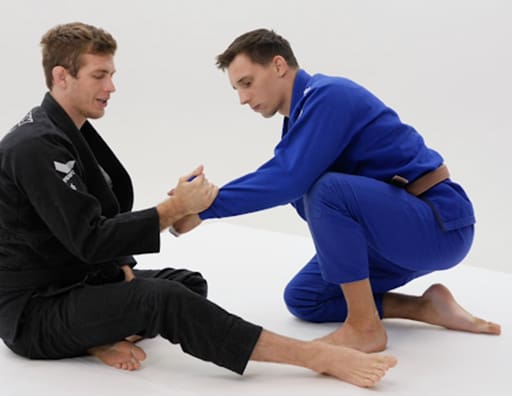
…is the pistol grip, generally used by “Old-School” proponents or those nursing injured fingers.
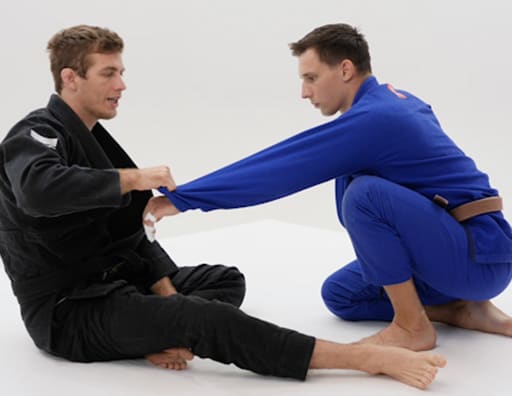
As the sleeve grip’s focus of control is on the limb, rather than the shoulder, it is restricted to be a pull only motion.
However, this doesn’t mean it will be impossible to generate any type of pushing force from a sleeve grip.
All you need to do is gain a secondary grip to help provide the opposing force…
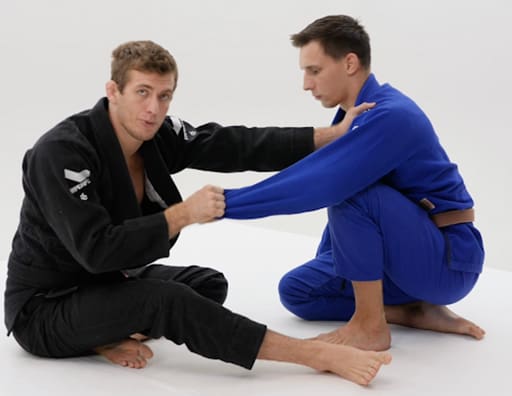
Either using a grip on the collar or…

Incorporating the use of your leg.
The main benefit of a sleeve grip control is found in its ability to expose your opponent’s arm by extending the defensive gap between their elbow and their body.
However, it is extremely important to note that while you are able to control your opponent’s limb, you do not have control over the primary levers of the torso, i.e. the shoulders or hips.
A sleeve grip, even one that is accompanied by a secondary grip generally only provides control at the axis of the nearest joint, but unfortunately this where your control ends…
Meaning…
…you will not be able to dictate or influence the direction which your opponent will face.
Ok, so now we’ve briefly covered the pros and cons of the 3 traditional Jiu Jitsu grips, lets take a look now at the 2 overarching problems these 3 grips share…
The Overarching Problems Traditional Grips Face
These Grips are Relatively Easy to Break
I know, some of you just read that subheading and instantly thought, “Not my grips!”
The key word to take into account here is the word relatively…
…what it’s relative to, we’ll get to a little later.
But, it is important to know that fundamental grips can and are often broken…
This is why people tape their fingers…
The continual play of making and breaking grips happens a lot and unfortunately, we tend to lose a couple digits along the way…
…This is the dance of Jiu Jitsu.
This is why, at the highest level, the majority of gameplay is focused on establishing and breaking grips.
If these 3 traditional grips were ultimately unbreakable, hardly a match would ever go the distance.
As we’ve mentioned in other articles, the easiest and most effective counter to any move is the breaking of, or disallowance of, grip establishment.
Essentially…
The Grip Break = The Counter
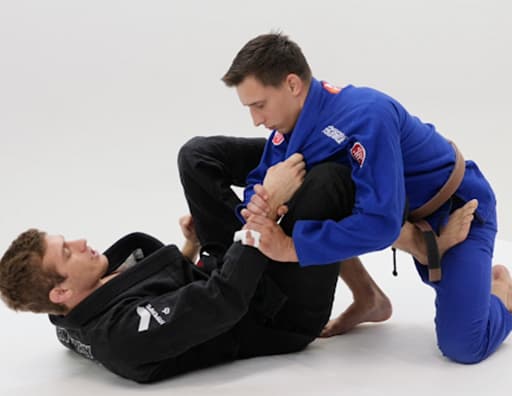
Here, from the same side collar grip, Keenan’s opponent is able to take a double grip over Keenan’s controlling wrist.
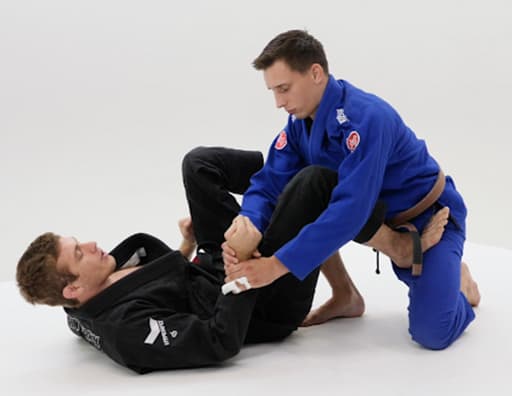
He then uses the force of his arms pushing Keenan’s grip hand away agianst the short aggressive upward movement of his torso…
From here, the opponent will use this grip break to…
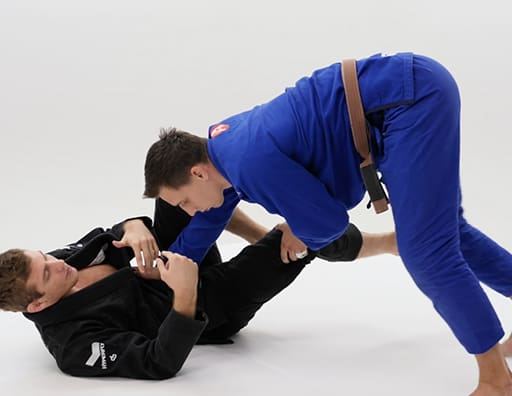
…Immediately mount their own attack, placing Keenan in a position without grips where he’ll poorly defend his opponent’s advance in position…
…essentially, Keenan went from 1 step ahead to 2 steps behind in his game.
The second overarching problem is a little more advanced in its concept, however, understanding this problem at the early belt levels will go a long way in preparing you for the big leagues.
And that problem involves…
The Concentration of End Line Control
Let’s take a look again at our 3 traditional grips, this time close up.
See if you can identify a common aspect across all three images…
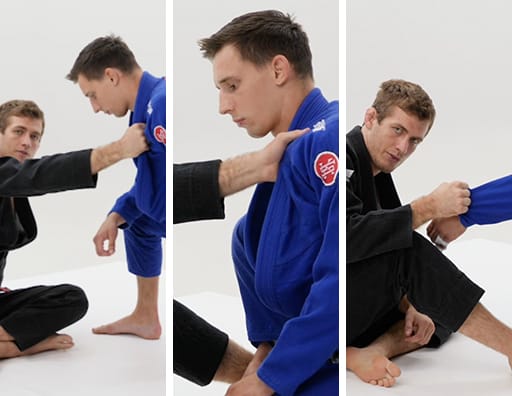
If you said the haircut of Keenan’s opponent is at near Mendes Bros level of perfection…
You’d be right.
But, if you also noticed the line of control traveling from Keenan’s hand to its endpoint on his opponent’s body equals the shoulder…
…give yourself a round of applause!
While this concentrated end line can provide awesome control over your opponent’s posture…
The initial attachment of these grips, without adding further pull, does nothing in terms of controlling your opponent’s direction…
Against a standing opponent, the focus of control at the shoulder is a poor mechanic for rotational when compared to the other primary lever of the body…
The hips.
Why does this matter?
One key ability your opponent needs in order to pass your guard is the ability to face you…
Controlling your opponent’s ability to face you, or taking that ability away from them all together, is an unbelievably powerful method for shutting down any and all guard passes.
So…
How Do You Solve These Overarching Problems?
There are many ways to solve these problems.
However, many solutions often mean many more hours of practice to get good at each of them…
It also means you may have to incorporate a specific solution for each problem ranging across a variety of situations…
Requiring you to add multiple new things to your game, when you’ve no doubt already have a million things on your mind…
This is where many of you die-hard traditionalists will probably roll your eyes…
…and probably start a fight in the comments.
But hear me out…
These overarching problems can all be solved, and solved easily, using Lapel Guard grips.
Specifically the Worm Guard and Squid Guard.
…cue eye roll.
Ok, so I’ve just made a pretty big claim and no doubt have been crossed off the Christmas list for a number of my old school friends.
But, before you get ready to crucify me, let me present my case…
Solving the Problem of Grip Breaking
Let’s approach this problem using the Worm Guard grip as an example…
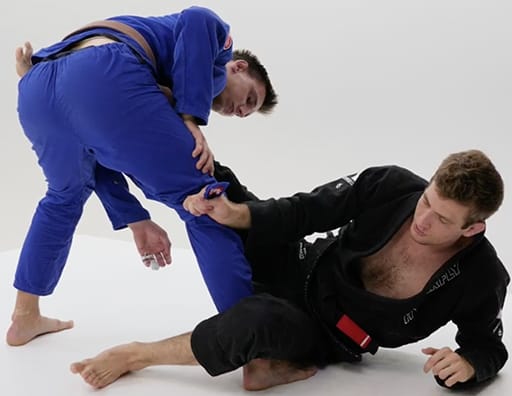
As you can see, the Worm Guard grip, once established, is far more of a complicated grip to break than a straight forward collar or sleeve grip.
The opponent is suffering from a number of issues preventing the application of the opposable force based break like we saw earlier…
The issues for the opponent here include…
- Severely restricted posture, which means the aggressive, short jolt backwards as an opposable force to break the grip is near impossible.
- Torso torsion, making finding and securing a grip to break movement against Keenan’s wrists extremely difficult.
- Distant and obstructed path to the grip, making it extremely difficult to even grab Keenan’s arm, as it is obstructed by Keenan’s leg, placed under his own leg and secured tightly in place by the lapel.
There are ways to unravel this spaghetti mess, and many DVD’s on the subject to boot…
However, comparing the time it takes to break and unravel this grip to the time it takes to break a traditional grip is like comparing apples and androids.
Plus, if the opponent did figure out a method for breaking the grip, they would not be in a position to mount their own attack so easily due to their need to still…
- Unravel the lapel.
- Remove the Worm Guard leg obstructing the hip.
- Square up and face you.
That’s 3 heavy time consuming obligations that YOU can exploit for your own fiendish delights.
Ok, so that’s one problem solved…
What about…
Improving the Concentration of End Line Control
Funny you ask…
Let’s take a look again at those 3 images from before…

While these grips are extremely good at controlling the upper primary lever of the body (the shoulders), against a standing opponent the degree of rotational control we have lessens as the other primary lever of control (the hips) become the dominant factor in our opponent’s ability to face us.
But…
If we choose to adopt a lapel grip, our concentration of end line control switches from the line of the shoulder to the line of the hips.
Let’s look at the illustration below…
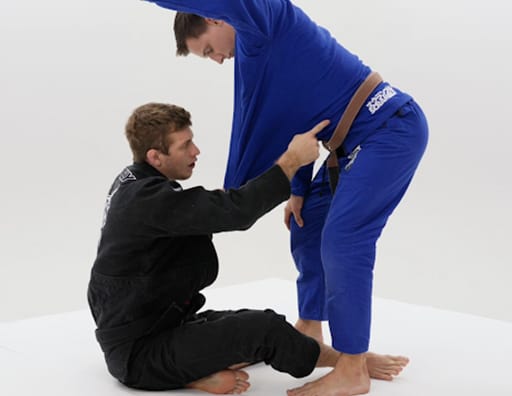
Here, we can see that tension has increased at the lowest level of the lapel, while slack is increased at the highest.
This is a complete inversion of the traditional grip, allowing for torsion at the hips and greater rotational control over our opponent, therefore the entirety of our opponent’s body.
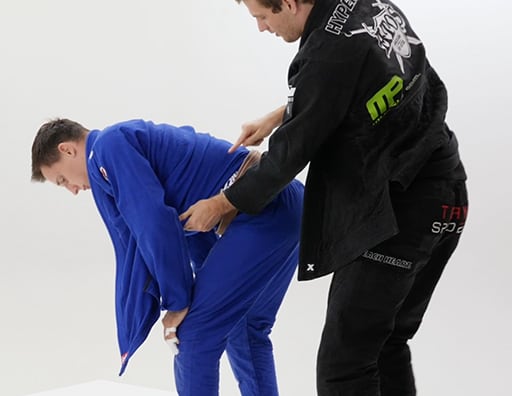
Furthermore, this tautness on the lapel doesn’t finish at the nearest joint like the traditional grips do on the shoulder.
Rather, concentration of end line control extends to the far hip, making the torque and rotational control of this grip much more effective.
Pairing this concept with further progressions of the Lapel Guard that we saw in our last section, that is the Worm Guard and Squid Guard, greatly increases the intensity of our rotational control as the lapel is weaved through and under our opponent’s limbs and hips.
Now we’ve solved the 2 overarching problems faced by the 3 most common traditional grips in BJJ, we now have to ask ourselves…
Does that mean that lapel grips are foolproof?
Of course not! Nothing in this world is perfect…
Especially not in the Jiu Jitsu world…
2 Problems Faced By the Lapel Guard Grip
While the lapel grips featured in guards like Lapel Guard, Worm Guard and Squid Guard were created to solve issues like these, and many more, it doesn’t mean they’re flawless.
Like everything in life, all good things come with a trade off…
- Much like the spider guard, to control distance and create a pushing mechanic, lapel grips will need an auxiliary control. Usually an added leg or foot…
- Lapel Guards, Worm Guards and Squid Guards take more time to set up compared to traditional guards…
However, playing either of these guards, or using a lapel based grip, shouldn’t be a gamble for you…
You don’t have to race against the clock to establish your grips…
Having to incorporate another limb for control shouldn’t leave you with preoccupied limbs you can’t attack with…
If you want to learn more about how to use these grips to dominate your opponents, both in the gym and in competition, you can find it all plus a whole lot more covered in great detail within the Lapel Encyclopedia!
Head on over to the LAPEL ENCYCLOPEDIA today to get your copy!
Or if you’d like to get a sample of the LAPEL ENCYCLOPEDIA before you buy, simply enter your details into the box below and we’ll send you 3 FREE videos over 3 days. PLUS opting in below means you’ll also be added to our newsletter, where you’ll benefit from FREE technique videos, updates on our latest products and amazing deals you won’t find anywhere else.

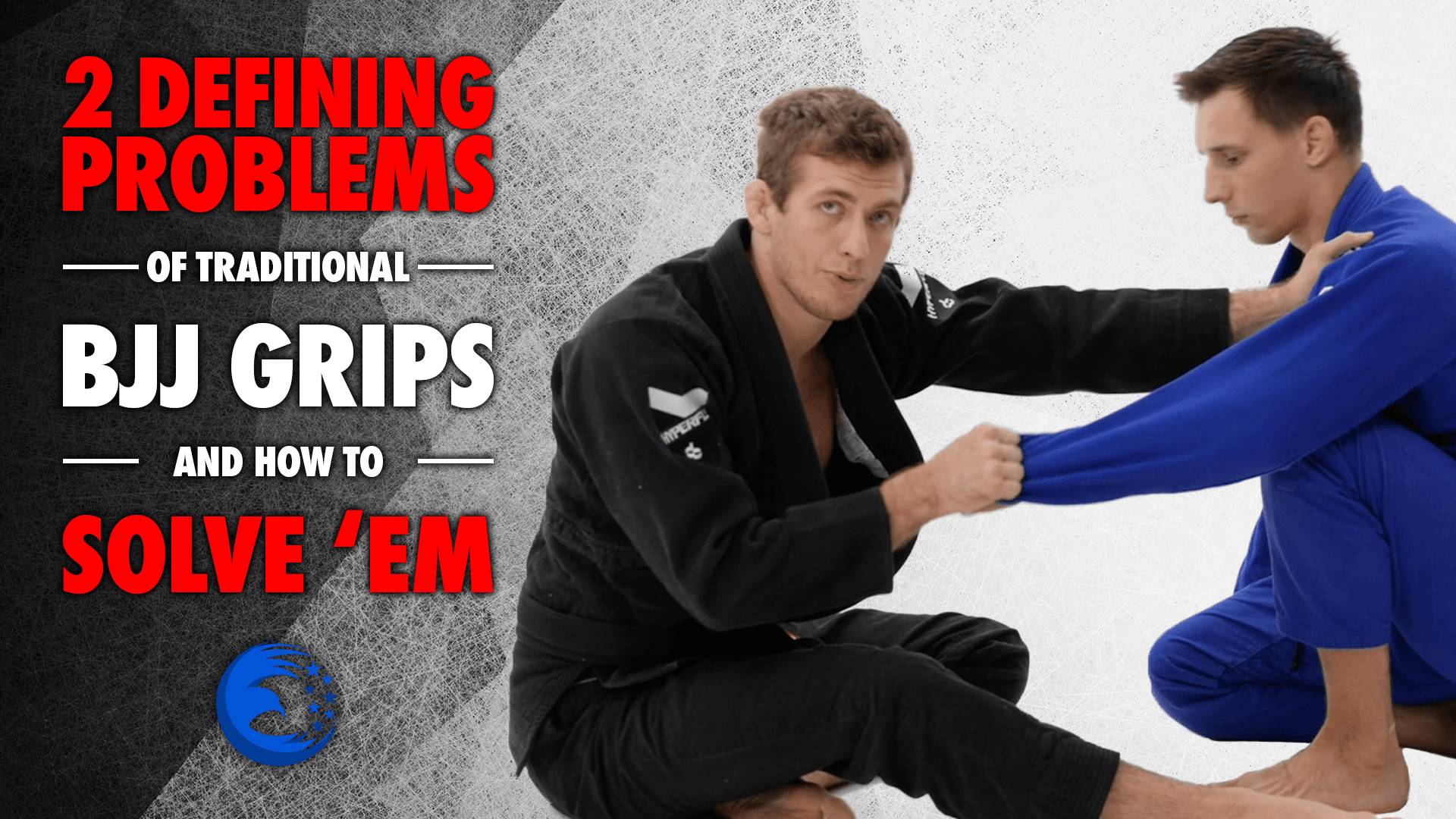
I’m ready.
Looks pretty good covers a lot of information. I think you need to explain how to break grips. More on that.
We covered it all in lapelguard.com 🙂
Send me this HUGE project you’re raving about…. please.
FOK! (Fountain of Knowledge) :))
FOKing right 😉
Love your take on grips Keenan! Definitely gets overlooked in training and progressing one’s jiu jitsu.
cool.
thank you
Small person who loves playing guard. Would like to learn more about lapel guard.
Nice blog, very interested in learning more about the different lapel guards